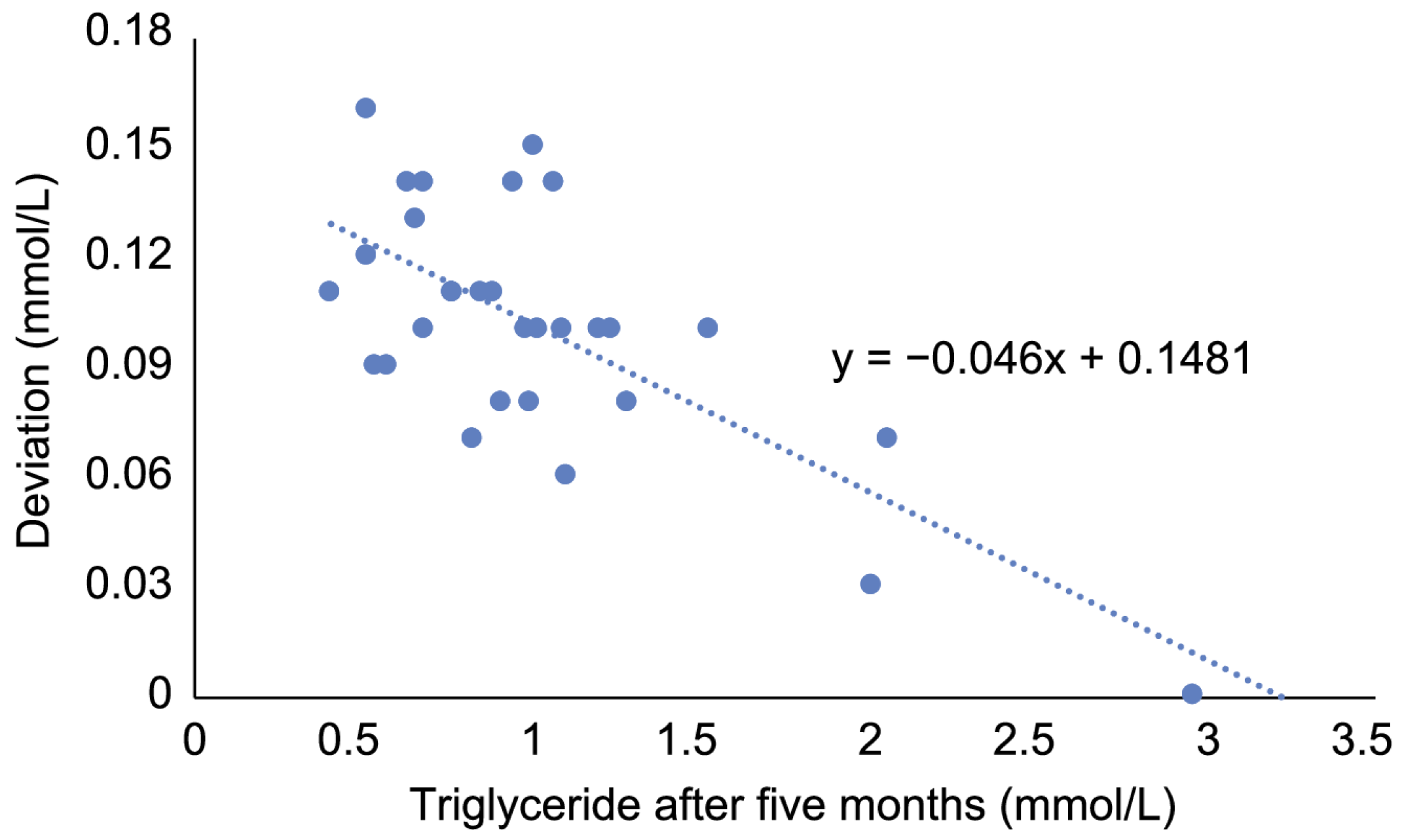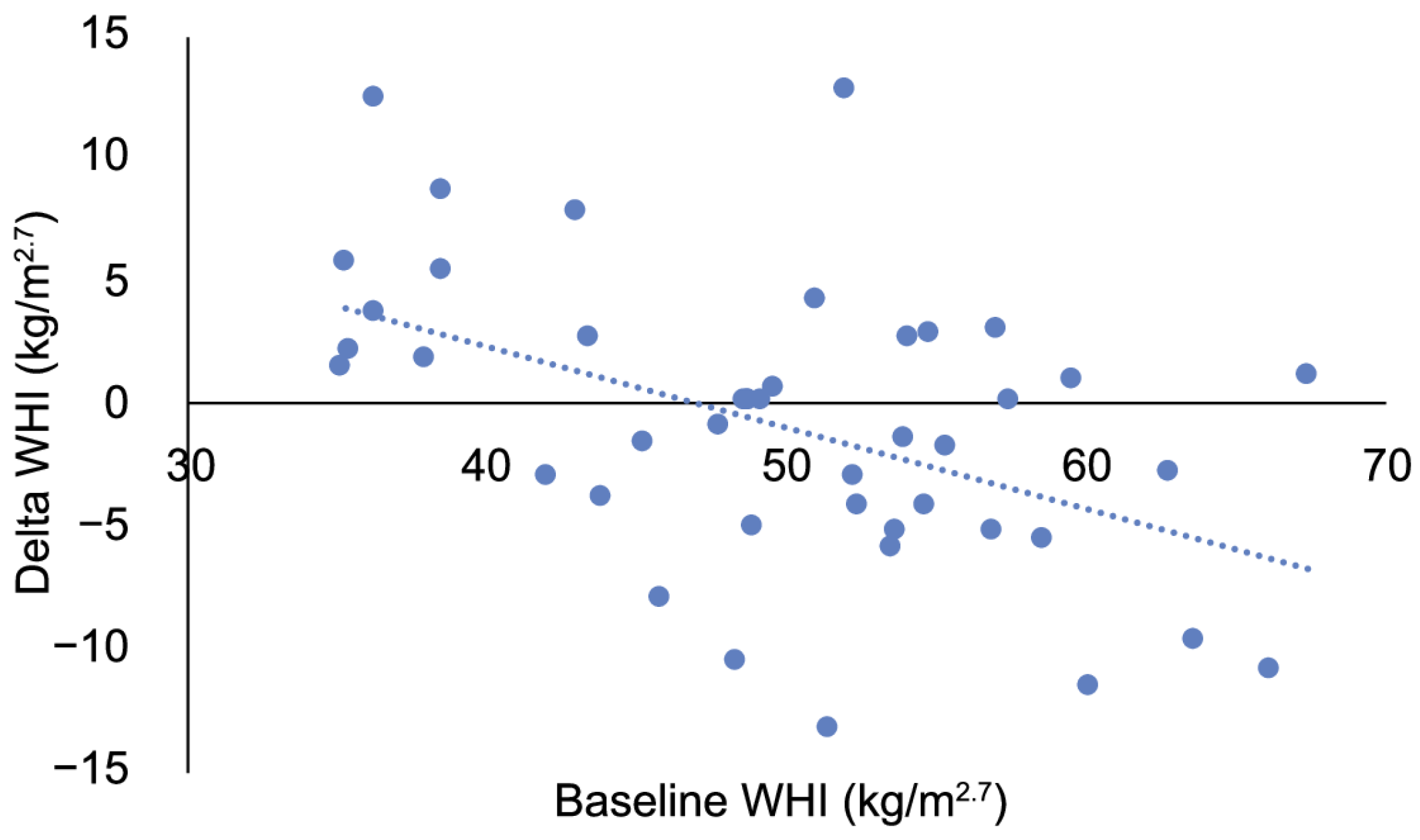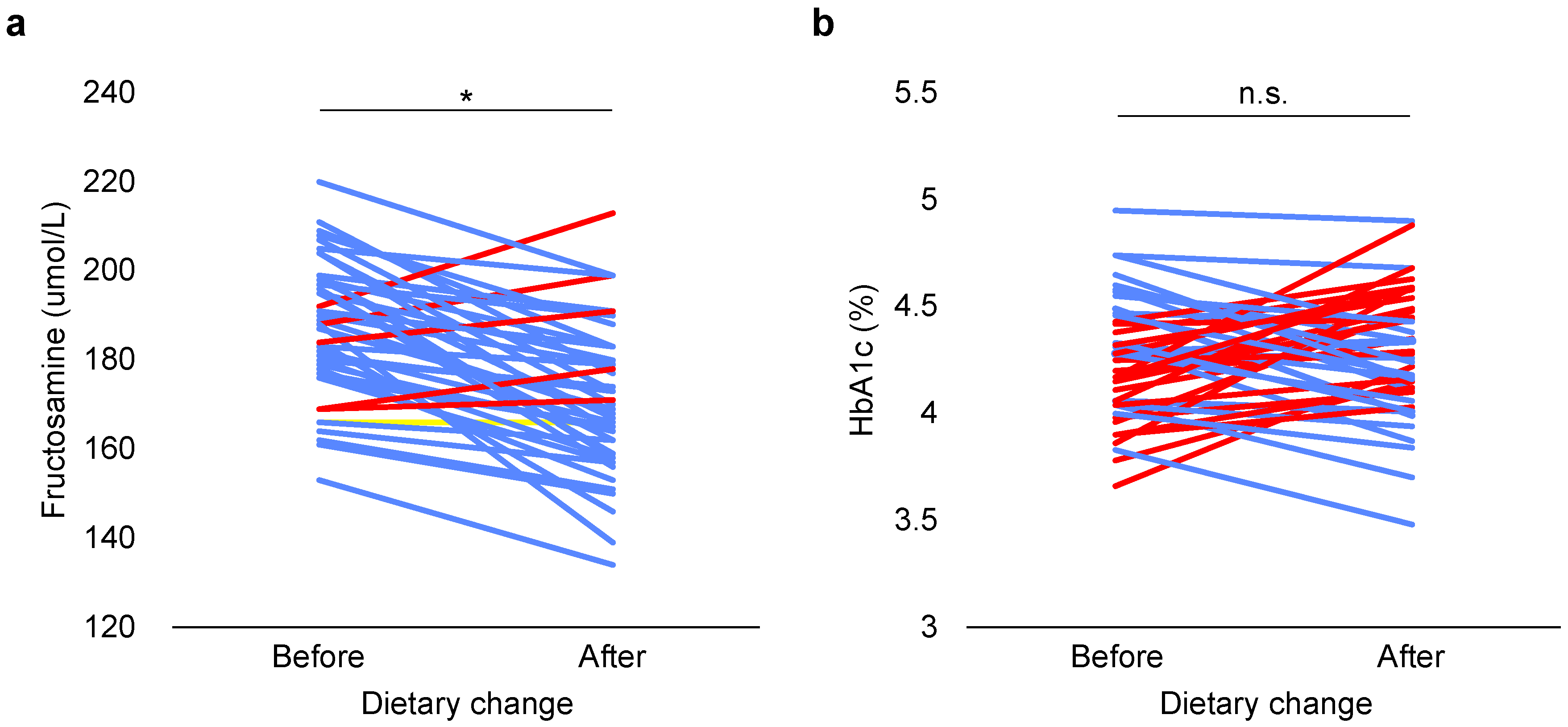Retrospective Evaluation of a Minor Dietary Change in Non-Diabetic Group-Housed Long-Tailed Macaques (Macaca fascicularis)
Abstract
:Simple Summary
Abstract
1. Introduction
2. Materials and Methods
2.1. Subjects and Housing
2.2. Diet and Dietary Change
2.3. Data Collection
2.4. Data Analyses
3. Results
3.1. Relative Adiposity and Overweight Status
3.2. Biochemical Parameters
3.2.1. Glycemic Response
3.2.2. Lipid Metabolism
4. Discussion
4.1. Relative Adiposity and Overweight Status
4.2. Glycemic Response
4.3. Lipid Metabolism
5. Conclusions
Author Contributions
Funding
Institutional Review Board Statement
Data Availability Statement
Acknowledgments
Conflicts of Interest
Appendix A
| Fruit/Vegetable | Energy (kcal) | Protein (gram) | Carbohydrates (gram) | Fiber (gram) | Fat (gram) |
|---|---|---|---|---|---|
| Banana | 110 | 1.32 | 24.0 | 2.28 | 0.36 |
| Bell pepper | 30 | 0.84 | 4.68 | 3.00 | 0.24 |
| Cabbage | 43 | 2.88 | 4.92 | 4.92 | 0.24 |
| Chicory | 23 | 1.56 | 2.88 | 1.44 | 0.24 |
| Chinese cabbage | 20 | 1.20 | 2.40 | 3.00 | 0.00 |
| Cucumber | 16 | 0.84 | 1.56 | 0.72 | 0.48 |
| Endive | 19 | 1.80 | 1.20 | 2.04 | 0.36 |
| Leek | 34 | 1.80 | 4.20 | 3.60 | 0.24 |
| Lettuce | 16 | 1.68 | 0.36 | 1.44 | 0.48 |
| Tomato | 24 | 0.84 | 3.48 | 1.56 | 0.48 |
| Fructosamine (umol/L) | HbA1c (%) | Cholesterol (mmol/L) | Triglyceride (mmol/L) | |
|---|---|---|---|---|
| Fructosamine (umol/L) | X | Pearson, r = 0.025, p = 0.873 | Pearson, r = 0.229, p = 0.135 | Spearman, r = 0.205, p = 0.182 |
| HbA1c (%) | Pearson, r = 0.233, p = 0.127 | X | Pearson, r = -0.370, p = 0.014 | Spearman, r = 0.071, p = 0.646 |
| Cholesterol (mmol/L) | Pearson, r = -0.223, p = 0.145 | Pearson, r = 0.035, p = 0.822 | X | Spearman, r = −0.010, p = 0.950 |
| Triglyceride (mmol/L) | Spearman, r = 0.212, p = 0.167 | Spearman, r = 0.220, p = 0.151 | Spearman, r = −0.012, p = 0.940 | X |
Appendix B

References
- Kemnitz, J.W.; Francken, G.A. Characteristics of spontaneous obesity in male rhesus monkeys. Physiol. Behav. 1986, 38, 477–483. [Google Scholar] [CrossRef]
- Shively, C.A.; Clarkson, T.B. Regional Obesity and Coronary Artery Atherosclerosis in Females: A Non-human Primate Model. Acta Med. Scand. 2009, 222, 71–78. [Google Scholar] [CrossRef]
- Hansen, B.C.; Bodkin, N.L. Heterogeneity of insulin responses: Phases leading to Type 2 (non-insulin-dependent) diabetes mellitus in the rhesus monkey. Diabetologia 1986, 29, 713–719. [Google Scholar] [CrossRef] [PubMed] [Green Version]
- Hanya, G. Diet of a Japanese Macaque Troop in the Coniferous Forest of Yakushima. Int. J. Primatol. 2004, 25, 55–71. [Google Scholar] [CrossRef]
- Hill, D.A. Seasonal variation in the feeding behavior and diet of Japanese macaques (Macaca fuscata yakui) in lowland forest of Yakushima. Am. J. Primatol. 1997, 43, 305–322. [Google Scholar] [CrossRef]
- Sarker, G.C.; Kabir, M.M.; Feeroz, M.M.; Hasan, M.K. Food and feeding behaviour of Rhesus Macaque (Macaca mulatta) at Barmi, Gazipur, Bangladesh. Bangladesh J. Life Sci. 2008, 20, 1–8. [Google Scholar]
- Yeager, C.P. Feeding ecology of the long-tailed macaque (Macaca fascicularis) in Kalimantan Tengah, Indonesia. Int. J. Primatol. 1996, 17, 51–62. [Google Scholar] [CrossRef]
- Kassim, N.; Hambali, K.; Amir, A. Nutritional Composition of Fruits Selected by Long-Tailed Macaques (Macaca fascicularis) in Kuala Selangor, Malaysia. Trop. Life Sci. Res. 2017, 28, 91–101. [Google Scholar] [CrossRef] [PubMed]
- Riley, E.P.; Tolbert, B.; Farida, W.R. Nutritional content explains the attractiveness of cacao to crop raiding Tonkean macaques. Curr. Zool. 2013, 59, 160–169. [Google Scholar] [CrossRef] [Green Version]
- Dittus, W.P.J. Arboreal adaptations of body fat in wild toque macaques (Macaca sinica) and the evolution of adiposity in primates. Am. J. Phys. Anthr. 2013, 152, 333–344. [Google Scholar] [CrossRef]
- Sterck, E.H.; Zijlmans, D.G.; de Vries, H.; van den Berg, L.M.; van Schaik, C.P.; Langermans, J.A. Determining overweight and underweight with a new weight-for-height index in captive group-housed macaques. Am. J. Primatol. 2019, 81, e22996. [Google Scholar] [CrossRef] [Green Version]
- Cabana, F.; Jasmi, R.; Maguire, R. Great ape nutrition: Low-sugar and high-fibre diets can lead to increased natural behaviours, decreased regurgitation and reingestion, and reversal of prediabetes. Int. Zoo Yearb. 2017, 52, 48–61. [Google Scholar] [CrossRef]
- West, D.B.; York, B. Dietary fat, genetic predisposition, and obesity: Lessons from animal models. Am. J. Clin. Nutr. 1998, 67 (Suppl. 3), 505S–512S. [Google Scholar] [CrossRef] [PubMed] [Green Version]
- Atkinson, F.; Foster-Powell, K.; Brand-Miller, J. International Tables of Glycemic Index and Glycemic Load Values: 2008. Diabetes Care 2008, 31, 2281–2283. [Google Scholar] [CrossRef] [Green Version]
- Dias, J.S. Nutritional Quality and Effect on Disease Prevention of Vegetables. Food Nutr. Sci. 2019, 10, 369–402. [Google Scholar] [CrossRef] [Green Version]
- Ludwig, D.S. The glycemic index: Physiological mechanisms relating to obesity, diabetes, and cardiovascular disease. JAMA 2002, 287, 2414–2423. [Google Scholar] [CrossRef]
- Augustin, L.; Kendall, C.; Jenkins, D.; Willett, W.; Astrup, A.; Barclay, A.; Björck, I.; Brand-Miller, J.; Brighenti, F.; Buyken, A.; et al. Glycemic index, glycemic load and glycemic response: An International Scientific Consensus Summit from the International Carbohydrate Quality Consortium (ICQC). Nutr. Metab. Cardiovasc. Dis. 2015, 25, 795–815. [Google Scholar] [CrossRef] [Green Version]
- Wagner, J.D.; Kavanagh, K.; Ward, G.M.; Auerbach, B.J.; Harwood, H.J.; Kaplan, J.R. Old World Nonhuman Primate Models of Type 2 Diabetes Mellitus. ILAR J. 2006, 47, 259–271. [Google Scholar] [CrossRef] [PubMed] [Green Version]
- Cefalu, W.T.; Wagner, J.D.; Bell-Farrow, A.D. Role of glycated proteins in detecting and monitoring diabetes in cynomolgus monkeys. Lab. Anim. Sci. 1993, 43, 73–77. [Google Scholar]
- Williams-Fritze, M.J.; Smith, P.C.; Zelterman, D.; Scholz, J. Fructosamine Reference Ranges in Rhesus Macaques (Macaca mulatta). J. Am. Assoc. Lab. Anim. Sci. 2011, 50, 462–465. [Google Scholar]
- Hamilton, C.L.; Kuo, P.T.; Feng, L.Y. Experimental Production of Syndrome of Obesity, Hyperinsulinemia and Hyperlipidemia in Monkeys. Exp. Biol. Med. 1972, 140, 1005–1008. [Google Scholar] [CrossRef]
- Kaumanns, W.; Krebs, E.; Singh, M. An endangered species in captivity: Husbandry and management of the lion-tailed macaque (Macaca silenus). mySCIENCE 2006, 1, 43–71. [Google Scholar]
- Vernes, M.K.; Louwerse, A.L. (Eds.) BPRC’s Enrichment Manual for Macaques & Marmosets; Biomedical Primate Research Center: Rijswijk, The Netherlands, 2010. [Google Scholar]
- National Research Council. Nutrient Requirements of Nonhuman Primates; The National Academies Press: Washington, DC, USA, 2003. [Google Scholar]
- Balansard, I.; Cleverley, L.; Cutler, K.L.; Spångberg, M.G.; Thibault-Duprey, K.; Langermans, J.A. Revised recommendations for health monitoring of non-human primate colonies (2018): FELASA Working Group Report. Lab. Anim. 2019, 53, 429–446. [Google Scholar] [CrossRef] [PubMed]
- Greene, S.A. Pros and cons of using α-2 agonists in small animal anesthesia practice. Clin. Tech. Small Anim. Pract. 1999, 14, 10–14. [Google Scholar] [CrossRef]
- Kanda, T.; Hikasa, Y. Effects of medetomidine and midazolam alone or in combination on the metabolic and neurohormonal responses in healthy cats. Can. J. Vet. Res. 2008, 72, 332–339. [Google Scholar] [PubMed]
- Nishimura, R.; Kim, H.-Y.; Matsunaga, S.; Hayashi, K.; Tamura, H.; Sasaki, N.; Takeuchi, A. Effects of Medetomidine-Midazolam on Plasma Glucose and Insulin Concentrations in Laboratory Pigs. J. Vet. Med. Sci. 1994, 56, 559–561. [Google Scholar] [CrossRef] [Green Version]
- Finley, P.R.; Tietz, N.W. (Eds.) Clinical Guide to Laboratory Tests; WB Saunders Company: Philadelphia, PA, USA, 1996; pp. 610–611. [Google Scholar]
- Howarth, N.C.; Saltzman, E.; Roberts, S.B. Dietary Fiber and Weight Regulation. Nutr. Rev. 2001, 59, 129–139. [Google Scholar] [CrossRef]
- Campbell, J.L.; Glenn, K.M.; Grossi, B.; Eisemann, J.H. Use of local North Carolina browse species to supplement the diet of a captive colony of folivorous primates (Propithecus sp.). Zoo Biol. 2001, 20, 447–461. [Google Scholar] [CrossRef]
- Nijboer, J.; Dierenfeld, E.S. Comparison of diets fed to southeast Asian colobines in North American and European zoos, with emphasis on temperate browse composition. Zoo Biol. 1996, 15, 499–507. [Google Scholar] [CrossRef]
- Fairbanks, L.A.; Blau, K.; Jorgensen, M.J. High-fiber diet promotes weight loss and affects maternal behavior in vervet monkeys. Am. J. Primatol. 2010, 72, 234–241. [Google Scholar] [CrossRef]
- Wilson, M.E.; Fisher, J.; Fischer, A.; Lee, V.; Harris, R.B.; Bartness, T.J. Quantifying food intake in socially housed monkeys: Social status effects on caloric consumption. Physiol. Behav. 2008, 94, 586–594. [Google Scholar] [CrossRef] [Green Version]
- Overduin-de Vries, A.M.; De Vries, H.; Vermande, M.M.; Reijntjes, A.H.; Sterck, E.H. Both aggressive and affiliative behaviour facilitate resource access in high-ranking female long-tailed macaques (Macaca fascicularis). Behaviour 2020, 157, 267–287. [Google Scholar] [CrossRef] [Green Version]
- Kemnitz, J.W.; Goy, R.W.; Flitsch, T.J.; Lohmiller, J.J.; Robinson, J.A. Obesity in Male and Female Rhesus Monkeys: Fat Distribution, Glucoregulation, and Serum Androgen Level. J. Clin. Endocrinol. Metab. 1989, 69, 287–293. [Google Scholar] [CrossRef]
- Chen, Y.; Ono, F.; Yoshida, T.; Yoshikawa, Y. Relationship between Body Weight and Hematological and Serum Biochemical Parameters in Female Cynomolgus Monkeys (Macaca fascicularis). Exp. Anim. 2002, 51, 125–131. [Google Scholar] [CrossRef] [Green Version]
- Raman, A.; Colman, R.J.; Cheng, Y.; Kemnitz, J.W.; Baum, S.T.; Weindruch, R.; Schoeller, D.A. Reference Body Composition in Adult Rhesus Monkeys: Glucoregulatory and Anthropometric Indices. J. Gerontol. Ser. A Boil. Sci. Med. Sci. 2005, 60, 1518–1524. [Google Scholar] [CrossRef] [PubMed] [Green Version]
- Schuurman, H.-J.; Smith, H.T. Reference values for clinical chemistry and clinical hematology parameters in cynomolgus monkeys. Xenotransplantation 2004, 12, 72–75. [Google Scholar] [CrossRef] [PubMed]
- Koga, T.; Kanefuji, K.; Nakama, K. Individual Reference Intervals of Hematological and Serum Biochemical Parameters in Cynomolgus Monkeys. Int. J. Toxicol. 2005, 24, 377–385. [Google Scholar] [CrossRef]
- Marigliano, M.; Casu, A.; Bertera, S.; Trucco, M.; Bottino, R. Hemoglobin A1C Percentage in Nonhuman Primates: A Useful Tool to Monitor Diabetes before and after Porcine Pancreatic Islet Xenotransplantation. J. Transplant. 2011, 2011, 1–8. [Google Scholar] [CrossRef] [PubMed] [Green Version]
- Xie, L.; Xu, F.; Liu, S.; Ji, Y.; Zhou, Q.; Wu, Q.; Gong, W.; Cheng, K.; Li, J.; Li, L.; et al. Age- and Sex-Based Hematological and Biochemical Parameters for Macaca fascicularis. PLoS ONE 2013, 8, e64892. [Google Scholar] [CrossRef] [PubMed] [Green Version]
- Yoshida, T.; Suzuki, K.; Cho, F.; Honjo, S. Age-related Changes of Hematological and Serum Biochemical Values in Cynomolgus Monkeys (Macaca fascicularis) Bred and Reared using the Indoor Individually-caged System. Exp. Anim. 1986, 35, 329–338. [Google Scholar] [CrossRef] [PubMed] [Green Version]
- Fernandes, R.A. Sex Differences in Glycosylated Hemoglobin in Mauritian Origin Long-Tailed Macaques (Macaca fascicularis). Master’s Thesis, Central Washington University, Ellensburg, WA, USA, 2018. [Google Scholar]
- Day, J.F.; Ingebretsen, C.G.; Ingebretsen, W.R.; Baynes, J.W.; Thorpe, S.R. Nonenzymatic glucosylation of serum proteins and hemoglobin: Response to changes in blood glucose levels in diabetic rats. Diabetes 1980, 29, 524–527. [Google Scholar] [CrossRef] [PubMed]
- Ryle, A.J.; Davie, S.; Gould, B.J.; Yudkin, J.S. A Study of the Effect of Diet on Glycosylated Haemoglobin and Albumin Levels and Glucose Tolerance in Normal Subjects. Diabet. Med. 1990, 7, 865–870. [Google Scholar] [CrossRef]
- Braatvedt, G.D.; Drury, P.L.; Cundy, T. Assessing glycaemic control in diabetes: Relationships between fructosamine and HbA1C. N. Z. Med. J. 1997, 110, 459–462. [Google Scholar]
- Cockram, C.; Pui, P.C.; Keung, C.C.; Moon, Y.; Swaminathan, R. A comparison of fructosamine and glycosylated haemoglobin measurements at a diabetic clinic. Diabetes Res. Clin. Pract. 1990, 9, 43–48. [Google Scholar] [CrossRef]
- Cohen, R.M.; Holmes, Y.R.; Chenier, T.C.; Joiner, C.H. Discordance Between HbA1c and Fructosamine: Evidence for a glycosylation gap and its relation to diabetic nephropathy. Diabetes Care 2003, 26, 163–167. [Google Scholar] [CrossRef] [Green Version]
- Narbonne, H.; Renacco, E.; Pradel, V.; Portugal, H.; Vialettes, B. Can fructosamine be a surrogate for HbA(1c) in evaluating the achievement of therapeutic goals in diabetes? Diabetes Metab. 2001, 27, 598–603. [Google Scholar] [PubMed]
- Davidson, M.B.; Schriger, D.L. Effect of age and race/ethnicity on HbA1c levels in people without known diabetes mellitus: Implications for the diagnosis of diabetes. Diabetes Res. Clin. Pract. 2010, 87, 415–421. [Google Scholar] [CrossRef]
- Roth, J.; Müller, N.; Lehmann, T.; Heinemann, L.; Wolf, G.; Müller, U.A. HbA1c and Age in Non-Diabetic Subjects: An Ignored Association? Exp. Clin. Endocrinol. Diabetes 2016, 124, 637–642. [Google Scholar] [CrossRef] [PubMed]
- Yang, Y.-C.; Lu, F.-H.; Wu, J.-S.; Chang, C.-J. Age and Sex Effects on HbA1c: A study in a healthy Chinese population. Diabetes Care 1997, 20, 988–991. [Google Scholar] [CrossRef]
- Cutler, R.G.; Davis, B.J.; Ingram, D.K.; Roth, G.S. Plasma Concentrations of Glucose, Insulin, and Percent Glycosylated Hemoglobin Are Unaltered by Food Restriction in Rhesus and Squirrel Monkeys. J. Gerontol. 1992, 47, B9–B12. [Google Scholar] [CrossRef] [PubMed]
- Jones, A.C.; Herndon, J.G.; Courtney, C.L.; Collura, L.; Cohen, J.K. Clinicopathologic Characteristics, Prevalence, and Risk Factors of Spontaneous Diabetes in Sooty Mangabeys (Cercocebus atys). Comp. Med. 2014, 64, 200–210. [Google Scholar] [PubMed]
- Hannon, B.A.; Thompson, S.V.; Edwards, C.G.; Skinner, S.K.; Niemiro, G.M.; Burd, N.A.; Holscher, H.D.; Teran-Garcia, M.; Khan, N.A. Dietary Fiber Is Independently Related to Blood Triglycerides Among Adults with Overweight and Obesity. Curr. Dev. Nutr. 2019, 3, nzy094. [Google Scholar] [CrossRef] [PubMed]
- Nishina, P.M.; Freedland, R.A. The Effects of Dietary Fiber Feeding on Cholesterol Metabolism in Rats. J. Nutr. 1990, 120, 800–805. [Google Scholar] [CrossRef]
- Haskell, W.L.; Spiller, G.A.; Jensen, C.D.; Ellis, B.K.; Gates, J.E. Role of water-soluble dietary fiber in the management of elevated plasma cholesterol in healthy subjects. Am. J. Cardiol. 1992, 69, 433–439. [Google Scholar] [CrossRef]
- Smucny, D.A.; Allison, D.B.; Ingram, D.K.; Roth, G.S.; Kemnitz, J.W.; Kohama, S.G.; Lane, M.A. Changes in blood chemistry and hematology variables during aging in captive rhesus macaques (Macaca mulatta). J. Med. Primatol. 2001, 30, 161–173. [Google Scholar] [CrossRef]
- Yu, W.; Hao, X.; Yang, F.; Ma, J.; Zhao, Y.; Li, Y.; Wang, J.; Xu, H.; Chen, L.; Liu, Q.; et al. Hematological and biochemical parameters for Chinese rhesus macaque. PLoS ONE 2019, 14, e0222338. [Google Scholar] [CrossRef] [PubMed] [Green Version]




| Food Item | Amount (gram) | Energy (kcal) | Protein (gram) | Carbs (gram) | Fiber (gram) | Fat (gram) | Glycemic Index [14] |
|---|---|---|---|---|---|---|---|
| Monkey chow | 90 | 295 | 22.7 | 32.5 | 3.78 | 3.87 | NA # |
| Fruit/vegetables | 120 | 33 | 1.48 | 4.97 | 2.40 | 0.31 | Low |
| Maize silage | 120 | 71 | 3.12 | 17.6 | 7.01 | 1.38 | Low |
| Grain mixture | 15 | 50 | 1.66 | 10.7 | 0.47 | 0.38 | Medium |
| Wheat bread | 30 | 59 | 2.20 | 11.8 | 1.34 | 0.40 | High |
| Nutritional Component | Before Dietary Change | After Dietary Change | Relative Change (%) |
|---|---|---|---|
| Energy (kcal) | 342 | 339 | −1.0% |
| Protein (gram) | 24.5 | 24.4 | −0.2% |
| Carbohydrates (gram) | 41.2 | 40.9 | −0.7% |
| Fiber (gram) | 5.45 | 6.29 | +15.4% |
| Fat (gram) | 4.23 | 4.35 | +3.0% |
| Before Dietary Change | After Dietary Change | |
|---|---|---|
| Fructosamine (umol/L) | 187 ± 2.3 (153–220) | 171 ± 2.5 (134–213) * |
| HbA1c (%) | 4.25 ± 0.04 (3.66–4.95) | 4.29 ± 0.04 (3.48–4.90) |
| Cholesterol (mmol/L) | 3.10 ± 0.08 (1.95–4.52) | 2.84 ± 0.10 (1.62–4.16) * |
| Triglyceride (mmol/L) | 1.02 ± 0.11 (0.24–3.68) | 1.05 ± 0.09 (0.33–3.51) |
Publisher’s Note: MDPI stays neutral with regard to jurisdictional claims in published maps and institutional affiliations. |
© 2021 by the authors. Licensee MDPI, Basel, Switzerland. This article is an open access article distributed under the terms and conditions of the Creative Commons Attribution (CC BY) license (https://creativecommons.org/licenses/by/4.0/).
Share and Cite
Zijlmans, D.G.M.; Maaskant, A.; Sterck, E.H.M.; Langermans, J.A.M. Retrospective Evaluation of a Minor Dietary Change in Non-Diabetic Group-Housed Long-Tailed Macaques (Macaca fascicularis). Animals 2021, 11, 2749. https://doi.org/10.3390/ani11092749
Zijlmans DGM, Maaskant A, Sterck EHM, Langermans JAM. Retrospective Evaluation of a Minor Dietary Change in Non-Diabetic Group-Housed Long-Tailed Macaques (Macaca fascicularis). Animals. 2021; 11(9):2749. https://doi.org/10.3390/ani11092749
Chicago/Turabian StyleZijlmans, Dian G. M., Annemiek Maaskant, Elisabeth H. M. Sterck, and Jan A. M. Langermans. 2021. "Retrospective Evaluation of a Minor Dietary Change in Non-Diabetic Group-Housed Long-Tailed Macaques (Macaca fascicularis)" Animals 11, no. 9: 2749. https://doi.org/10.3390/ani11092749






